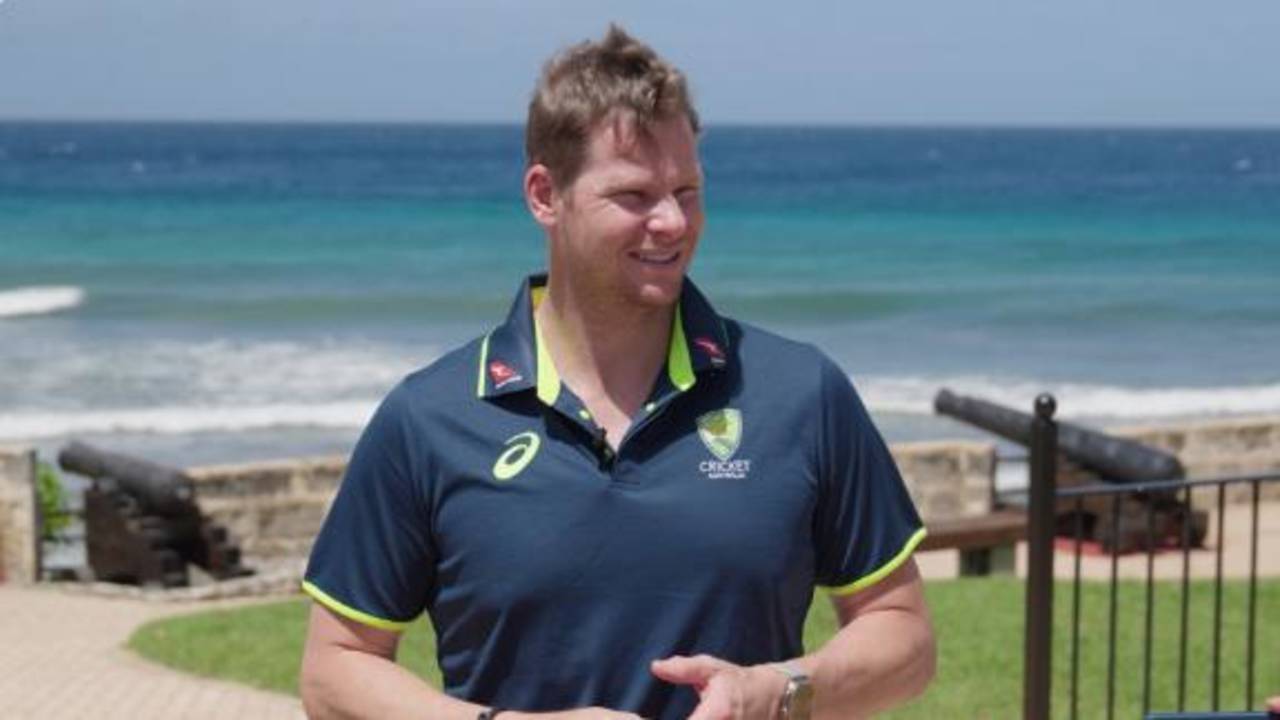Smith set to play but won't field in the slips because of injured finger
Smith faced fast bowlers without issue in the nets two days out from the Grenada Test, and looks set to replace Josh Inglis, but he will have to field in outfield due to his finger
Andrew McGlashan
01-Jul-2025
Steven Smith remains on track to make a return in the second Test against West Indies in Grenada, after his first full training session since suffering a compound dislocation of a finger against South Africa at Lord's. But Australia will have to rejig things in the field to accommodate him not being able to stand in the slips.
Smith spent a week at his apartment in New York while the Barbados Test was on and only had his stitches removed when he rejoined the squad. He will have to wear a splint for around six more weeks but the earlier confidence from both he and coach Andrew McDonald that he would be able to withstand the rigours of a Test appears to be bearing out.
In perfect weather on Tuesday at the National Stadium, the first time any of this Australia squad have set foot in the stadium, Smith initially faced throwdowns from assistant coach Matthew Wade in the nets at the back of the ground before moving to the centre-wicket pitches. He faced further throwdowns and the spin of Nathan Lyon before switching to the pace-bowling net where he took on team-mates Josh Hazlewood and Mitchell Starc, although they were not operating at top pace given the short turnaround between games.
It's understood that Smith came through the batting stint without problems. After leaving the nets, he had lengthy conversations with backroom staff including McDonald, selector George Bailey, and physio Nick Jones with some close attention paid to the injured right little finger and the splint Smith needs to wear.
"He seems pretty confident," Alex Carey had said before training began. "He's excited to get back in. It's been tough at the top of the order, so to add a little bit more experience is good for the group."
Assuming Smith does play, he will need to be managed in the field. He took some gentle slip catches after finishing batting but won't be able to take his usual place in the cordon. He occasionally felt his finger during the remainder of the fielding drills.
"Australia is still strong [without him] because of the system they have. They keep on producing guys. But we've seen when we add pressure as a bowling group, we did get 20 wickets in the Test and that's the first step towards winning"Daren Sammy on Steven Smith
Australia are preparing their cordon on the assumption that Smith will play. Beau Webster remained at second during practice after fielding there in the first Test, and Sam Konstas, who was at short leg and in the outfield during the first Test, came into third. Starc also caught some balls in the gully where he may slot in should Cameron Green move to the slips at any stage. In the first Test, Usman Khawaja stood at first slip to Lyon. Significantly, Josh Inglis, who filled Smith's spot at No. 4 in Barbados, did not practice in the slips.
Smith averages an eye-watering 124.57 in Tests against West Indies, which includes an unbeaten 200 in Perth in 2022 and 199 at Sabina Park on the 2015 tour. The last Test he played against them he was opening the batting at Gabba where he was unbeaten on 91 when West Indies secured their famous victory.
"He's a quality guy, a quality player," West Indies coach Daren Sammy said. "Australia is still strong [without him] because of the system they have. They keep on producing guys. But we've seen when we add pressure as a bowling group, we did get 20 wickets in the Test and that's the first step towards winning. Steve Smith, if he comes in, poses a different challenge to us."

Steven Smith fell for 199 in last Test in the Caribbean in 2015•AFP
Sammy suggested West Indies may look to rejig their own slip cordon after spilling seven catches in the last Test, with Brandon King potentially moving to first, where he sometimes fields in white-ball cricket, and Roston Chase shifting to the gully although that is perhaps not an ideal position for a captain.
"I think the biggest thing is we shot ourselves in the foot [in Barbados]," he said. "You cannot drop seven catches against the world's No. 1 team and expect to compete. We have a lot of blame to take for the defeat, but there were also some positives… for the first two days, we were head and shoulders against the No. 1 team."
Signs two days out suggest that the pitch in Grenada would not be nearly as lively as one served up at Kensington Oval. It had an even covering of dry grass and was given another heavy rolling between the two training session.
"We've played more white-ball cricket here," Sammy said. "It's normally a really good cricket wicket. [There's a] much more even cover of dead grass. I trust in the groundsmen, with what they're going to prepare. At the end of the day, you could have a grassy top or a flat deck, you have still got to be able to execute. That's what our challenge is about."
Andrew McGlashan is a deputy editor at ESPNcricinfo
